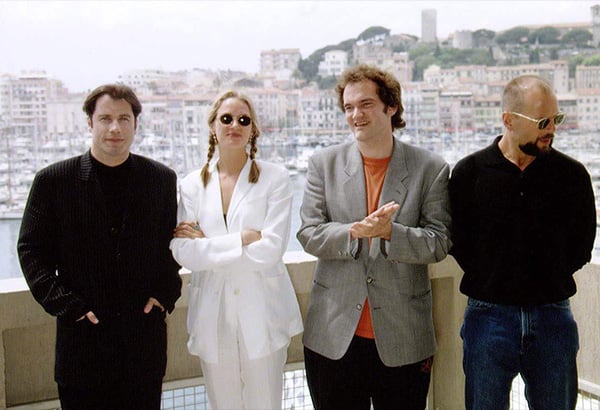
Get ready to dive into the movie world of Quentin Tarantino, a filmmaker (some say genius) renowned for crafting some of the most unforgettable dialogues in cinema history. Tarantino’s mastery of witty exchanges, sharp repartees, and rich pop culture references sets him apart as a true dialogue virtuoso. His conversations aren’t just filler; they’re the heartbeat of his films, driving character development and propelling the plot forward with a unique flair.
Simply put, Tarantino’s dialogue has the kind of ebb and flow that makes his movies infinitely identifiable, and that makes him, to us, one of the last remaining auteurs.
Let’s delve a little deeper into his filmmaking.
Tarantino’s dialogue is a playground of wit and humour, where every line crackles with energy. His characters often engage in conversations that are both hilarious and thought-provoking, blending everyday banter with philosophical musings. This signature style not only entertains but also reveals deeper layers of his characters, making them more relatable and memorable.
A hallmark of Tarantino’s dialogue is his penchant for pop culture references. From obscure film trivia to classic songs, these nods not only add a layer of relatability but also enrich the narrative. They ground his stories in a shared cultural context, making them resonate with audiences on a personal level while showcasing his deep love for cinema and music – all showcased through that whip-smart dialogue.
Tarantino’s films are renowned for their rapid-fire exchanges. Characters often engage in brisk, cutting conversations that reveal their personalities and intentions. This briskness creates a dynamic rhythm in his films, keeping viewers on their toes and heightening the tension in pivotal scenes.
When he puts on his writing shoes, Tarantino’s dialogue excels in fleshing out complex characters. Through their conversations, viewers gain insight into their motivations, fears, and desires. This depth allows Tarantino to create characters who are as intriguing as they are flawed, making their journeys all the more compelling.
Dialogue in Tarantino’s films is more than just conversation; it’s a key driver of the plot. His characters’ interactions often reveal crucial plot points and build suspense, ensuring that every line serves a purpose in advancing the story.
Tarantino often explores themes of moral ambiguity through his dialogue. Characters engage in philosophical debates and confrontations that challenge traditional notions of right and wrong (often while they’re engaging in those wrongs, themselves), adding layers of complexity to his narratives.
Tarantino’s dialogue is intricately woven into his visual storytelling. The interplay between what is said and what is shown creates a rich, immersive experience. His dialogue often complements the visual style of his films, enhancing the overall impact.
Tarantino’s use of editing goes beyond mere transitions between scenes; it becomes a tool for emphasising key moments and driving the narrative forward. For instance, in scenes where dialogue is crucial, Tarantino’s edits are timed to match the rhythm of the characters’ speech, ensuring that each line lands with precision. This deliberate pacing helps to create a sense of urgency or relaxation, depending on the scene’s needs.
The sharp cuts typical of Tarantino’s style often juxtapose contrasting elements, such as calm dialogue with sudden bursts of violence or humour, creating a disorienting yet engaging viewing experience. These edits not only maintain the viewer’s attention but also enhance the emotional resonance of the scenes.
Overall, Tarantino’s distinctive editing style and pacing are essential in shaping the unique rhythm of his films. They work in tandem with his memorable dialogues, ensuring that every conversation is both impactful and unforgettable.
Tarantino’s dialogue is known for its rhythmic cadence, clever wordplay, and the way it delves into mundane yet intriguing conversations that reveal deeper aspects of characters. This unique approach has encouraged filmmakers to experiment with dialogue in ways that prioritise character development and thematic depth.
Moreover, Tarantino’s films often feature non-linear storytelling and extensive character monologues, which have influenced how narrative structures are approached in modern cinema. His ability to weave complex, interrelated storylines and develop rich, multifaceted characters, using dialogue as a storytelling tool, has prompted many filmmakers to adopt similar techniques, aiming to craft narratives that are both intricate and engaging.
In essence, Quentin Tarantino’s impact extends beyond just dialogue; it encompasses a holistic approach to filmmaking that encourages experimentation and creativity. His influence is evident in the works of many contemporary filmmakers who continue to draw inspiration from his unique style, making him a pivotal figure in the evolution of modern cinema.
Quentin Tarantino’s dialogue is more than just words; it’s an art form that shapes his films and defines his legacy. As his movies continue to captivate audiences, his conversations remain a testament to his unparalleled skill in crafting unforgettable movie moments.
For more news and articles on your favourite movies, franchises and more, click here.
For updates on upcoming releases, follow our Facebook page.
To see what’s showing in a Ster-Kinekor theatre near you, click here.